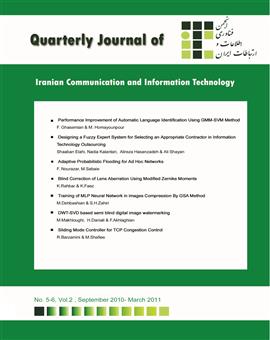اصلاح نقص ابیراهی لنز دوربین با بهرهگیری از مومنتهاي زرنیک
الموضوعات :
1 - دانشگاه آزاد اسلامی واحد تهران مرکز
2 - دانشگاه صنعتی امیرکبیر
الکلمات المفتاحية: ابیرایی لنز, چند جمله ای زرنیک, طیفهای مرتبه بالاتر,
ملخص المقالة :
کاهش کیفیت تصویر در یک سامانه اپتیکی تابع پارامترهای متفاوتی از قبیل ابیرایی لنز، خطای رقمی سازی و خطای مونتاژ سامانه می باشد. از این میان مقاله حاضر قصد دارد تا به مطالعه ابیرایی لنز پرداخته و نقص ابیرایی آن را اصلاح و جبران نماید. برای این منظور مومنتهای زرنیک جهت مدل سازی ابیرایی معرفی شده و ضرایب آن جهت تخمین در دو کلاس متقارن و نامتقارن دسته بندی میشوند. سپس این ضرایب با بهرهگیری از آنالیز چند طیفی تخمین زده میشوند. جهت این مهم در تخمین ضرایب جملات متقارن از آنالیز tri-coherence و برای ضرایب جملات نامتقارن از آنالیز bi-coherence استفاده شده است. با مد نظر قرار دادن دقت نتایج حاصله در مقام قیاس با نتایج تخمین ابیرایی با بهرهگیری از آنالیز چند طیفی نشان میدهد که روش پیشنهادی میتواند به دقت 1/0 پیکسل دست یابد.
[1] V. Orekhov, B. Abidi, C. Broaddus, M. Abidi, “Universal camera calibration with automatic distortion model selection,” IEEE International Conference on Image Processing (ICIP'07), Oct. 19 2007, San Antonio, TX, USA.
[2] R. Grompone von Gioi, P. Monasse, J.-N. Morel, Z.Tang, “Towards High-precision Lens Distortion Correction,” ICIP2010, Proceeding of 2010 IEEE 17th International Conference on Image Processing, Sep 26-29, (2010), 4237-4241, Hong Kong.
[3] C.Y. Vincent, T. Tjahajadi, “Multiview camera-calibration framework for nonparametric distortion removal,” IEEE Transactions on Robotics, Vol. 21, p.p. 1004 - 1009, Oct. 2005
[4] C. Lin, S. Chang, Y. Lay, M. Yeh, C. Lee, “Automatic distortion measurement system with reticle positioning for enhance accuracy,” Elsevier: Measurement, 41 (2008) 960-969.
[5] M. Ahmed, A. Farag, “Nonmetric Calibration of Camera Lens Distortion: Differetial Methods and Robust Estimation”, IEEE Transaction on Image Processing, Vol. 14, No. 8, Aug 2005.
[6] R. Hartley, S. Bing Kang, “Parameter-Free Radial Distortion Correction with Center of Distortion Estimation,” IEEE Transaction on Pattern Analysis and Machine Intelligence, Vol. 29, No. 8, Aug 2007.
[7] S. Aritan, “Efficiency of non-linear lens distortion models in biomechanical analysis of human movement,” Elsevier: Measurement 43 (2010) 739-746
[8] V.N. Mahajan, “Optical Imaging and Aberration,” SPIE Press, 1998.
[9] C. Ricolf-Viala, A. Sanchez Salmeron, “Correcting non-linear lens distortion in cameras without using a model,” Elsevier: Optics & Laser Technology, 42 (2010) 628-639.
[10] D. Trodoff, D.W. Murray, “The impact of radial distortion on the self-calibration of rotating cameras,” Elsevier: Computer Vision and Image Understanding, 96 (2004) 17-34.
[11] C. Hughes, R. Mc/feely, P. Denny, M. Glavin, E. Jones, “Equidistant (fθ) fish-eye perspective with application in distortion centre estimation,” Elsevier: Image and Vision Computing, 28 (2010) 538-551.
[12] F. Devernay, O. Faugeras, “Straight lines have to be straight,” Machine Vision and Applications (2001) 13: 14-24.
[13] J. Lin, M. Xing, D. Sha, D. Su, T. Shen, “Distortion measurement of CCD imaging system with short focal length and large-field objective,” Elsevier: Optics and Lasers in Engineering, 43 (2005) 1137-1144.
[14] J. Tardif, P. Strum, M. Trudeau, S. Roy, “Calibration of Cameras with Radially Symmetric Distortion,” IEEE Transaction on Pattern Analysis and Machine Intelligence, Vol. 31, No. 9, Sep 2009.
[15] H. Farid, A. Popescu, “Blind Removal of Lens Distortion,” Journal of the Optical Society of America A, 18 (9) (2001) 2072-2078.
[16] W. Yu, “Image-based lens geometric distortion correction using minimization of average bicoherence index,” Elsevier: Pattern Recognition, 37 (2004) 1175-1187.
[17] Fackrell, J.W.A., McLaughlin, S., Collis, W.B., White, P.R., "Nonlinearity Detection For Condition Monitoring Using Higher-Order Statistics," IEEE Transactions on Biomedical Engineering, 1994.
[18] F. Devernay, “A Non-Maxima Suppression Method for Edge Detection with Sub-Pixel Accuracy,” INRIA Rapport de recherche, No. 2724, November 1995.


